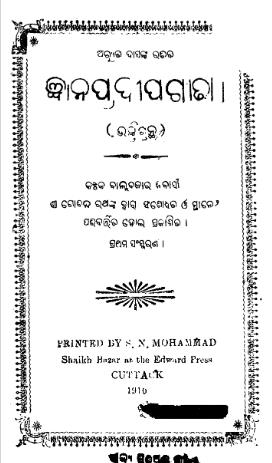Published in 1910, Gyanapradipa Gita, edited by Gobinda Rath, is a landmark work in the realm of Odia poetry, showcasing the profound spiritual and philosophical insights of Achyuta Das. The title translates to The Lamp of Knowledge, aptly reflecting the book’s mission to illuminate the minds of readers. This collection not only serves as a poetic exploration of wisdom and spirituality but also embodies the cultural and literary revival that was taking place in Odisha during the early 20th century.
The early 1900s were a period of significant transformation for India, characterized by a blend of traditional values and modern ideas. In Odisha, this era saw a resurgence of interest in regional literature and culture, driven by a wave of nationalist sentiments and social reform movements. Gyanapradipa Gita emerged from this rich cultural tapestry, aiming to provide readers with a deeper understanding of life through poetic expression. Achyuta Das, a prominent poet and thinker of his time, sought to harness the power of poetry to convey profound truths and philosophical concepts.
Gyanapradipa Gita is imbued with themes of knowledge, enlightenment, and the pursuit of truth. Each poem within the collection serves as a meditative reflection on various aspects of existence, encouraging readers to seek wisdom and inner peace. The verses delve into the complexities of human emotions, the nature of the universe, and the interconnectedness of all beings.
One of the remarkable features of this work is its ability to blend philosophical discourse with poetic beauty. Das draws upon Hindu scriptures, metaphysical concepts, and moral teachings, weaving them into evocative imagery and lyrical compositions. This fusion creates a rich tapestry of thought that encourages readers to engage with the text on multiple levels—intellectually, emotionally, and spiritually.
Achyuta Das’s writing style in Gyanapradipa Gita is characterized by clarity and elegance. He employs a range of poetic devices, including vivid imagery, allegory, and symbolism, which serve to enhance the depth of his messages. The rhythmic flow of his verses adds a musical quality to the poetry, inviting readers to savor each line.
Moreover, the choice of language reflects both the accessibility of the content and the richness of the Odia linguistic tradition. Das’s use of simple yet profound expressions allows readers from various backgrounds to connect with the themes of the work, making it a valuable resource not just for scholars but also for the common reader seeking understanding and inspiration.
The impact of Gyanapradipa Gita extends beyond its immediate literary significance. The work has played a crucial role in the evolution of modern Odia poetry, paving the way for future generations to explore similar themes of spirituality and philosophical inquiry. It has inspired numerous poets and thinkers to harness the poetic form as a means of exploring and expressing complex ideas.
Additionally, as a part of the broader movement toward cultural revival during its time, Gyanapradipa Gita serves as a reminder of the importance of literature in shaping social consciousness and identity. By encouraging readers to seek knowledge and enlightenment, Das’s work aligns with the larger goals of fostering a more thoughtful and introspective society.
Books Info
| Books name | Gyanapradipa Gita /ଜ୍ଞାନପ୍ରଦୀପ ଗୀତା |
| Author | Achyuta Das; Gobinda Rath, Ed. |
| No Of pages | 38 |
| Publisher | Sri Gobinda Ratha |
| Publication | 1910 |
| Printed At | The Edward Press |
| Distributor | NA |

